小学英语语法-动词
- 格式:pptx
- 大小:1.61 MB
- 文档页数:19
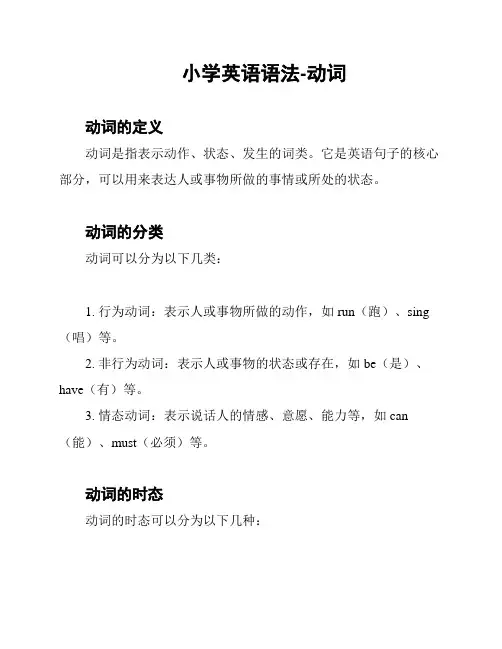
小学英语语法-动词动词的定义动词是指表示动作、状态、发生的词类。
它是英语句子的核心部分,可以用来表达人或事物所做的事情或所处的状态。
动词的分类动词可以分为以下几类:1. 行为动词:表示人或事物所做的动作,如run(跑)、sing (唱)等。
2. 非行为动词:表示人或事物的状态或存在,如be(是)、have(有)等。
3. 情态动词:表示说话人的情感、意愿、能力等,如can (能)、must(必须)等。
动词的时态动词的时态可以分为以下几种:1. 现在时:表示目前正在进行的动作或常规的动作,如play (玩)、eat(吃)等。
2. 过去时:表示过去发生的动作或状态,如ran(跑过)、ate (吃过)等。
3. 将来时:表示将来将要发生的动作或状态,如will play(将要玩)、will eat(将要吃)等。
动词的变化形式动词在不同的时态中会有不同的变化形式,如:1. 现在时的第三人称单数形式:在现在时中,当主语是第三人称单数(he、she、it)时,动词要加上-s或-es。
例如:She plays football(她踢足球)。
2. 过去式的变化形式:在过去时中,一般情况下,动词要加上-ed或-d。
例如:They played together yesterday(昨天他们一起玩)。
3. 现在分词和过去分词的形式:现在分词一般以-ing结尾,过去分词一般以-ed结尾。
例如:He is swimming in the pool(他正在游泳)。
以上是关于小学英语动词的基本知识,希望能对您有所帮助。
参考资料:。
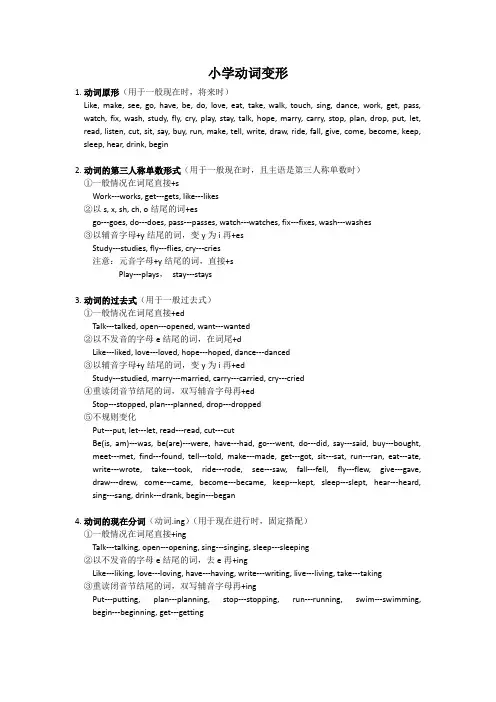
小学动词变形1.动词原形(用于一般现在时,将来时)Like, make, see, go, have, be, do, love, eat, take, walk, touch, sing, dance, work, get, pass, watch, fix, wash, study, fly, cry, play, stay, talk, hope, marry, carry, stop, plan, drop, put, let, read, listen, cut, sit, say, buy, run, make, tell, write, draw, ride, fall, give, come, become, keep, sleep, hear, drink, begin2.动词的第三人称单数形式(用于一般现在时,且主语是第三人称单数时)①一般情况在词尾直接+sWork---works, get---gets, like---likes②以s, x, sh, ch, o结尾的词+esgo---goes, do---does, pass---passes, watch---watches, fix---fixes, wash---washes③以辅音字母+y结尾的词,变y为i再+esStudy---studies, fly---flies, cry---cries注意:元音字母+y结尾的词,直接+sPlay---plays,stay---stays3.动词的过去式(用于一般过去式)①一般情况在词尾直接+edTalk---talked, open---opened, want---wanted②以不发音的字母e结尾的词,在词尾+dLike---liked, love---loved, hope---hoped, dance---danced③以辅音字母+y结尾的词,变y为i再+edStudy---studied, marry---married, carry---carried, cry---cried④重读闭音节结尾的词,双写辅音字母再+edStop---stopped, plan---planned, drop---dropped⑤不规则变化Put---put, let---let, read---read, cut---cutBe(is, am)---was, be(are)---were, have---had, go---went, do---did, say---said, buy---bought, meet---met, find---found, tell---told, make---made, get---got, sit---sat, run---ran, eat---ate, write---wrote, take---took, ride---rode, see---saw, fall---fell, fly---flew, give---gave, draw---drew, come---came, become---became, keep---kept, sleep---slept, hear---heard, sing---sang, drink---drank, begin---began4.动词的现在分词(动词.ing)(用于现在进行时,固定搭配)①一般情况在词尾直接+ingTalk---talking, open---opening, sing---singing, sleep---sleeping②以不发音的字母e结尾的词,去e再+ingLike---liking, love---loving, have---having, write---writing, live---living, take---taking③重读闭音节结尾的词,双写辅音字母再+ingPut---putting, plan---planning, stop---stopping, run---running, swim---swimming, begin---beginning, get---getting。
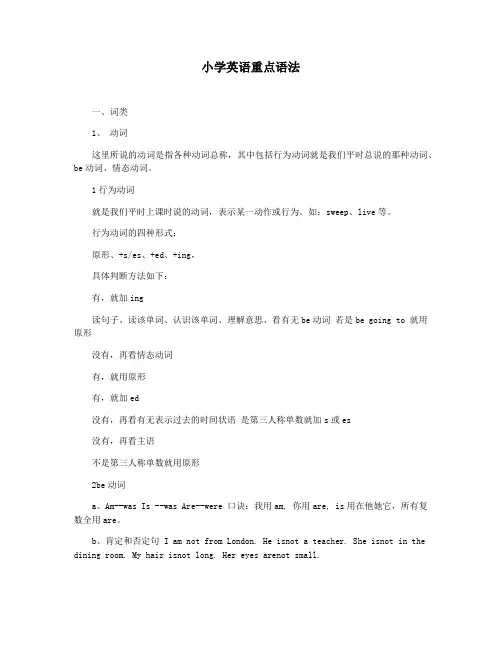
小学英语重点语法一、词类1、动词这里所说的动词是指各种动词总称,其中包括行为动词就是我们平时总说的那种动词、be动词、情态动词。
1行为动词就是我们平时上课时说的动词,表示某一动作或行为。
如:sweep、live等。
行为动词的四种形式:原形、+s/es、+ed、+ing,具体判断方法如下:有,就加ing读句子、读该单词、认识该单词、理解意思、看有无be动词若是be going to 就用原形没有,再看情态动词有,就用原形有,就加ed没有,再看有无表示过去的时间状语是第三人称单数就加s或es没有,再看主语不是第三人称单数就用原形2be动词a、Am--was Is --was Are--were 口诀:我用am, 你用are, is用在他她它,所有复数全用are。
b、肯定和否定句 I am not from London. He isnot a teacher. She isnot in the dining room. My hair isnot long. Her eyes arenot small.c、一般疑问句Am I a Chinese? Yes, you are. No, you aren’t. Are they American? Yes, they are. No, they aren’t. Is the cat fat? Yes, it is. No, it isn’t.我们现在学过的be动词大致分两类:is、am、are为一类,一般用于一般现在时、现在进行时和一般将来时中,was和were为另一类,一般用于一般过去时。
判断步骤:第一、三人称单数,就用was有,再看人称第二人称单数和所有复数,就用were看有无表示过去的时间状语第一人称单数,就用am没有,再看人称→第三人称单数,就有is第二人称单数和所有复数,就用are2、名词表示某一事物,有具体的和抽象的之分。
判断的关键词往往是be动词,be动词如果是am、is或was,名词就用原形;be动词如果是are或were,名词就加s或es。
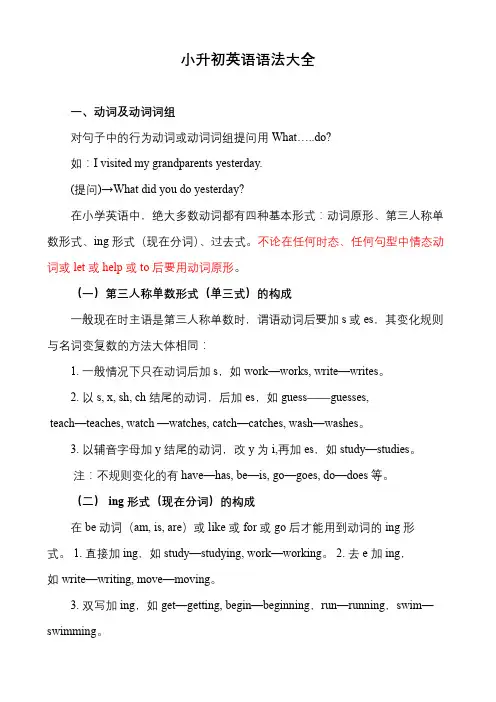
小升初英语语法大全一、动词及动词词组对句子中的行为动词或动词词组提问用What…..do?如:I visited my grandparents yesterday.(提问)→What did you do yesterday?在小学英语中,绝大多数动词都有四种基本形式:动词原形、第三人称单数形式、ing形式(现在分词)、过去式。
不论在任何时态、任何句型中情态动词或let或help或to后要用动词原形。
(一)第三人称单数形式(单三式)的构成一般现在时主语是第三人称单数时,谓语动词后要加s或es,其变化规则与名词变复数的方法大体相同:1.一般情况下只在动词后加s,如work—works,write—writes。
2.以s,x,sh,ch结尾的动词,后加es,如guess——guesses, teach—teaches,watch—watches,catch—catches,wash—washes。
3.以辅音字母加y结尾的动词,改y为i,再加es,如study—studies。
注:不规则变化的有have—has,be—is,go—goes,do—does等。
(二)ing形式(现在分词)的构成在be动词(am,is,are)或like或for或go后才能用到动词的ing形式。
1.直接加ing,如study—studying,work—working。
2.去e加ing,如write—writing,move—moving。
3.双写加ing,如get—getting,begin—beginning,run—running,swim—swimming。
(三)过去式的构成规则1.一般情况直接加ed,如ask—asked,work—worked。
2.以e结尾,只加d,如dance—danced。
3.以辅音字母加y结尾,把y变为i,再加ed,如study—studied。
4.先双写末尾一个字母,再加ed,如stop—stopped。
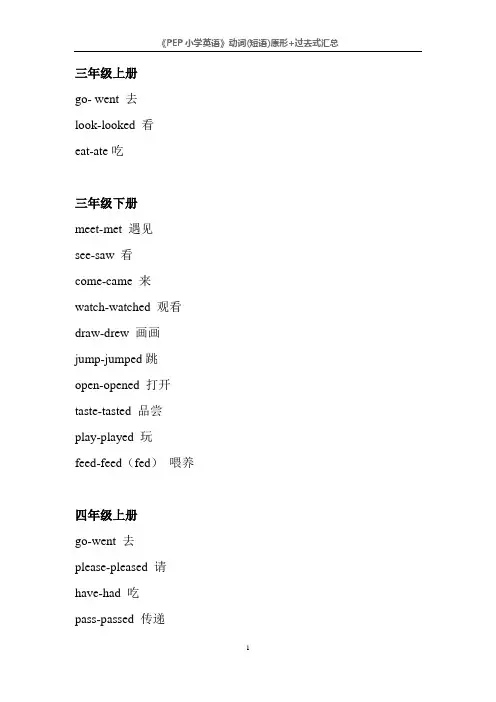
三年级上册go- went 去look-looked 看eat-ate吃三年级下册meet-met 遇见see-saw 看come-came 来watch-watched 观看draw-drew 画画jump-jumped跳open-opened 打开taste-tasted 品尝play-played 玩feed-feed(fed)喂养四年级上册go-went 去please-pleased 请have-had 吃pass-passed 传递use-used 使用四年级下册run-run 跑get up-got up 起床go to school-went to school 去学校go home-went home 回家go to bed-went to bed 上床睡觉wear-wore 穿put on-put on 穿上close-closed 关want-wanted想要take-took 买五年级上册know-knew 知道fun-funned 逗笑wait-waited 等待do homework-did homework 写作业watch-TV-watched TV 看电视read books-read books 看书play-computer-did housework 做家务cook the meals-cooked the meals 做饭empty the trash-emptied the flowers 浇花sweep the floor-swept the floor 扫地clean the bedroom-打扫教室wash the windows-washed the windows 擦窗户make the bed-made the bed铺床set the table-set the table 摆饭桌wash the clothes-washed the clothes 洗衣服do the dishes-did the dishes 洗碗碟put away the clothes-put away the clothes收拾衣服play chess-played chess 下棋tell-told 说work-worked 工作use a computer-used a computer 使用计算机have a try-had a try 试一试五年级下册do morning exercises -did morning exercises 晨练eat breakfast-ate breakfast 吃早饭have English class-had English class 上英语课play sports-played sports 进行体育运动eat dinner-ate dinner 吃晚饭climb mountains-climbed mountains 爬山go shopping-went shopping 购物go hiking-went hiking 去远足play the piano-played the piano 弹钢琴visit grandparent-visited grandparent 看望(外)祖父母fly kites-flew kites 放风筝plant trees-planted tress 种树make a snowman-made a snowman 堆雪人swim-swan 游泳skate-skated 滑冰sleep-slept 睡觉draw pictures-drew pictures 画画cook dinner-cooked dinner 做饭read a book-read a book 看书answer the phone-answered the phone 接电话listen to music-listened the music 听音乐clean the room-cleaned the room 打扫房间write a letter-wrote a letter 写信write an e-mail-wrote a letter 写电子邮件fly-flew 飞jump-jumped 跳run-ran 跑climb-climbed 往上爬fight-fought 打架swing-swang 荡秋千take-took 讲话drink water-drank water喝水send-sent 寄take picture-took pictures 照相watch insects-watched insects 观察昆虫pick up leaves-picked up leaves 采摘树叶do an experiment-did an experiment 做实验catch butterflies-caught butterflies 捉蝴蝶count leaves-collected leaves 收集树叶write a report-wrote a report 写报告play chess-played chess下棋六年级上册go to school-went to school 上学stop-stopped 停get to-got to到达find-found 寻找remember-remembered 记住mean-meant 意思是drive-drove 驾驶buy-bought 购买turn-turned 转弯get off-got off 下车ride a bike-rode a bike 骑自行车dive-dived跳水live-lived 居住teach-taught 教go-went 去play the violin-played the violin 拉小提琴make kites-made kites 制作风筝collect stamps-collected stamps 集邮design-designed 设计say-said 说六年级下册Think-thought 思考study-studied 学习kick-kicked 踢bounce-bounced 反弹go swimming-went swimming 游泳go fishing-went fishing 钓鱼study-studied 学习learn-learned 学习sing-sang唱歌dance-danced 跳舞row-rowed 划(船)go skiing-went skiing 去滑雪leave-left 离开hear-heard 听见trip-tripped 旅行have a fever 发烧hurt-hurt 疼痛have a cold-had a cold 伤风have a toothache-had a toothache 牙疼have a headache-had a headache 头疼have a sore throat-had a sore throat 喉咙疼。
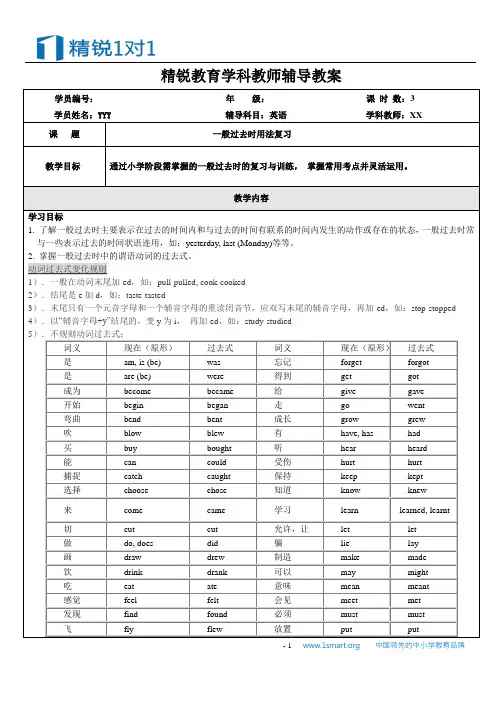
精锐教育学科教师辅导教案学员编号:年级:课时数:3学员姓名:YYY辅导科目:英语学科教师:XX课题一般过去时用法复习教学目标通过小学阶段需掌握的一般过去时的复习与训练,掌握常用考点并灵活运用。
教学内容学习目标1. 了解一般过去时主要表示在过去的时间内和与过去的时间有联系的时间内发生的动作或存在的状态,一般过去时常与一些表示过去的时间状语连用,如:yesterday, last (Monday)等等。
2. 掌握一般过去时中的谓语动词的过去式。
动词过去式变化规则1).一般在动词末尾加-ed,如:pull-pulled, cook-cooked2).结尾是e加d,如:taste-tasted3).末尾只有一个元音字母和一个辅音字母的重读闭音节,应双写末尾的辅音字母,再加-ed,如:stop-stopped 4).以“辅音字母+y”结尾的,变y为i,再加-ed,如:study-studied5).不规则动词过去式:词义现在(原形)过去式词义现在(原形)过去式是am, is (be) was 忘记forget forgot是are (be) were 得到get got成为become became 给give gave开始begin began 走go went弯曲bend bent 成长grow grew吹blow blew 有have, has had买buy bought 听hear heard能can could 受伤hurt hurt捕捉catch caught 保持keep kept选择choose chose 知道know knew来come came 学习learn learned, learnt切cut cut 允许,让let let做do, does did 躺lie lay画draw drew 制造make made饮drink drank 可以may might吃eat ate 意味mean meant感觉feel felt 会见meet met发现find found 必须must must飞fly flew 放置put put读read read 将shall should骑、乘ride rode 唱歌sing sang响、鸣ring rang 坐下sit sat跑run ran 睡觉sleep slept说say said 说speak spoke看见see saw 度过spend spent扫sweep swept3. 掌握一般过去时的陈述句肯定形式:一般过去时的陈述句肯定形式由主语加上动词的过去式构成。
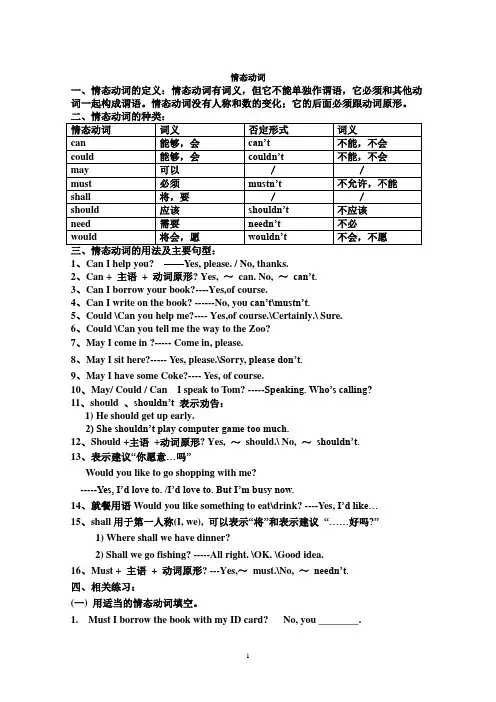
情态动词一、情态动词的定义:情态动词有词义,但它不能单独作谓语,它必须和其他动词一起构成谓语。
情态动词没有人称和数的变化;它的后面必须跟动词原形。
1、Can I help you? ——Yes, please. / No, thanks.2、Can + 主语+ 动词原形? Yes, ~can. No, ~can’t.3、Can I borrow your book?----Yes,of course.4、Can I write on the book? ------No, you can’t\mustn’t.5、Could \Can you help me?---- Yes,of course.\Certainly.\ Sure.6、Could \Can you tell me the way to the Zoo?7、May I come in ?----- Come in, please.8、May I sit here?----- Yes, please.\Sorry, please don’t.9、May I have some Coke?---- Yes, of course.10、May/ Could / Can I speak to Tom? -----Speaking. Who’s calling?11、should 、shouldn’t 表示劝告:1) He should get up early.2) She shouldn’t play computer game too much.12、Should +主语+动词原形? Yes, ~should.\ No, ~shouldn’t.13、表示建议“你愿意…吗”Would you like to go shopping with me?-----Yes, I’d love to. /I’d love to. But I’m busy now.14、就餐用语Would you like something to eat\drink? ----Yes, I’d like…15、shall用于第一人称(I, we), 可以表示“将”和表示建议“……好吗?”1) Where shall we have dinner?2) Shall we go fishing? -----All right. \OK. \Good idea.16、Must + 主语+ 动词原形? ---Yes,~must.\No, ~needn’t.四、相关练习:(一) 用适当的情态动词填空。
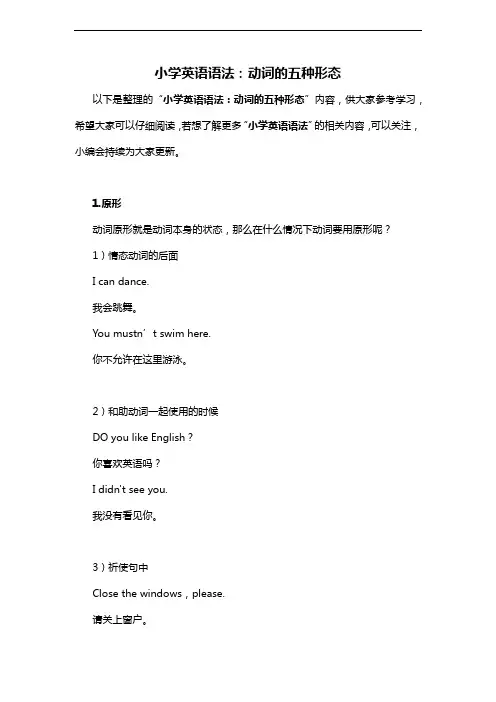
小学英语语法:动词的五种形态以下是整理的“小学英语语法:动词的五种形态”内容,供大家参考学习,希望大家可以仔细阅读,若想了解更多“小学英语语法”的相关内容,可以关注,小编会持续为大家更新。
1.原形动词原形就是动词本身的状态,那么在什么情况下动词要用原形呢?1)情态动词的后面I can dance.我会跳舞。
You mustn’t swim here.你不允许在这里游泳。
2)和助动词一起使用的时候DO you like English?你喜欢英语吗?I didn't see you.我没有看见你。
3)祈使句中Close the windows,please.请关上窗户。
Don't make a noise.别吵闹。
4)动词不定式to doI like to pat my dog.我喜欢抚摸我的小狗。
They want to go shopping.他们想去购物。
5)某些固定搭配I saw a dog run into the room.我看见小狗跑进了房间。
Why not go with me?为什么不和我一起走?l often help my mother do some housework. 我经常帮妈妈做家务。
Have him send the letter.让他去寄信。
Don't make us cry.不要让我们哭泣。
2.第三人称单数形式在一般现在时态中,如果主语是第三人称单数——除了I 和you 的另一个个体,谓语动词要用第三人称单数的形式,其变化规律在一般现在时态这个章节中将重点论述。
He gets up at seven every day.他每天七点起床。
The little dog likes to eat bones.小狗喜欢吃骨头。
3.过去式在句子的一般过去时态中,谓语动词要用动词的过去式。
其变化规律在一般过去时态这个章节中重点论述。
I went to the park yesterday.我昨天去公园了。
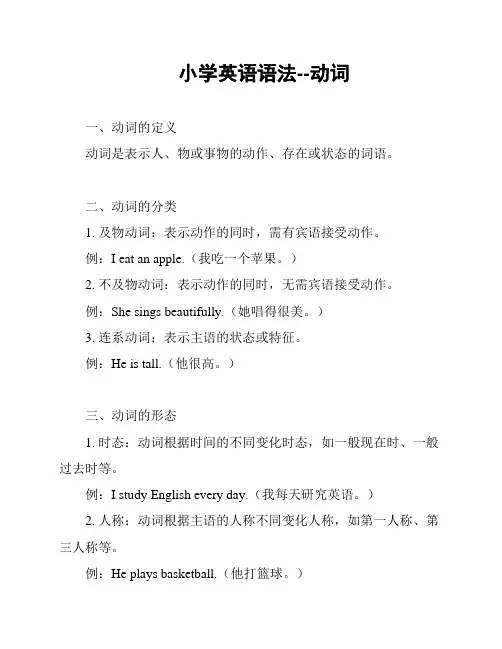
小学英语语法--动词一、动词的定义动词是表示人、物或事物的动作、存在或状态的词语。
二、动词的分类1. 及物动词:表示动作的同时,需有宾语接受动作。
例:I eat an apple.(我吃一个苹果。
)2. 不及物动词:表示动作的同时,无需宾语接受动作。
例:She sings beautifully.(她唱得很美。
)3. 连系动词:表示主语的状态或特征。
例:He is tall.(他很高。
)三、动词的形态1. 时态:动词根据时间的不同变化时态,如一般现在时、一般过去时等。
例:I study English every day.(我每天研究英语。
)2. 人称:动词根据主语的人称不同变化人称,如第一人称、第三人称等。
例:He plays basketball.(他打篮球。
)3. 数量:动词根据主语的数量不同变化数量,如单数形式、复数形式等。
例:The cat meows.(猫叫。
)The cats meow.(猫叫。
)四、动词的用法1. 动词的时态用法:根据句子的时间关系,选择合适的时态。
2. 动词的人称用法:动词的形式要和主语的人称保持一致。
3. 动词的被动语态用法:根据需要表示动作的主体和客体关系,使用被动语态。
4. 动词的情态动词用法:使用情态动词来表示能力、惯、推测等。
五、注意事项- 动词的时态、人称、数量等要与句子的主语和语境保持一致。
- 需要注意动词的规则和不规则变化形式。
六、练题请根据下列句子,选择合适的动词填空。
1. I ___ English every day. (study/studies)2. She ___ to school by bus. (go/goes)3. They ___ playing soccer in the park. (is/are)4. He ___ a letter to his friend. (writes/write)5. The cat ___ happily. (meows/meow)参考答案:1. study2. goes3. are4. writes5. meows。
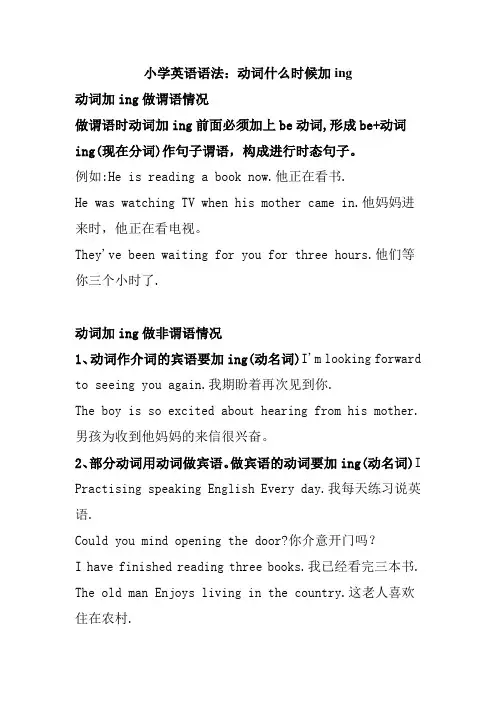
小学英语语法:动词什么时候加ing动词加ing做谓语情况做谓语时动词加ing前面必须加上be动词,形成be+动词ing(现在分词)作句子谓语,构成进行时态句子。
例如:He is reading a book now.他正在看书.He was watching TV when his mother came in.他妈妈进来时,他正在看电视。
They've been waiting for you for three hours.他们等你三个小时了.动词加ing做非谓语情况1、动词作介词的宾语要加ing(动名词)I'm looking forward to seeing you again.我期盼着再次见到你.The boy is so excited about hearing from his mother.男孩为收到他妈妈的来信很兴奋。
2、部分动词用动词做宾语。
做宾语的动词要加ing(动名词)I Practising speaking English Every day.我每天练习说英语.Could you mind opening the door?你介意开门吗?I have finished reading three books.我已经看完三本书. The old man Enjoys living in the country.这老人喜欢住在农村.3、一些固定句式后面要加动词ing(现在分词)We have fun Playing in the park on Sunday.Most students have problems speaking English.4、动词修饰名词做后置定语时,要加ing(现在分词)There is a boy Crying over there.I felt something moving in the house.I heard someone singing in the next room.5、动词做主语和表语时,动词要加ing(动名词)Swimming is very popular in summer.His job is teaching English.综上所述,动词在以上六种情况需要加ing!。
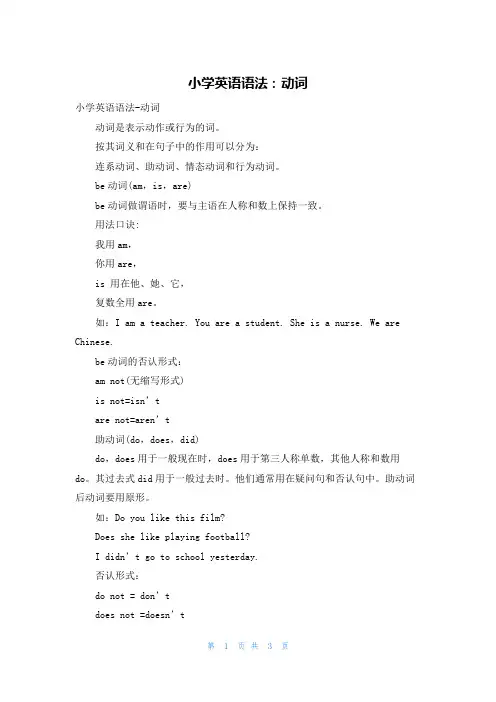
小学英语语法:动词小学英语语法-动词动词是表示动作或行为的词。
按其词义和在句子中的作用可以分为:连系动词、助动词、情态动词和行为动词。
be动词(am,is,are)be动词做谓语时,要与主语在人称和数上保持一致。
用法口诀:我用am,你用are,is 用在他、她、它,复数全用are。
如:I am a teacher. You are a student. She is a nurse. We are Chinese.be动词的否认形式:am not(无缩写形式)is not=isn’tare not=aren’t助动词(do,does,did)do,does用于一般现在时,does用于第三人称单数,其他人称和数用do。
其过去式did用于一般过去时。
他们通常用在疑问句和否认句中。
助动词后动词要用原形。
如:Do you like this film?Does she like playing football?I didn’t go to school yesterday.否认形式:do not = don’tdoes not =doesn’tdid not=didn’t情态动词(can,may,must,should,will,would,shall 等)情态动词表示说话人对某一动作或状态的态度,表示“可能〞,“可以〞,“需要〞,“必须〞,“应当〞等意思。
情态动词没有人称和数的变化,后面的动词要用原形。
can和may都可以用来表示请求或允许,但may比can更正式,更客气些。
如:Can I use your pen?May I come in?must和shouldmust意为“必须,应当〞,含有一种命令的语气,比拟生硬,不容商量。
should意为“应当,应该〞,表示建议或劝告,语气比拟委婉,客气。
如:You must finish your homework before you go to bed.You should stay in bed and have a good rest.will和would用于疑问句,表示说话人向对方提出请求或询问,用would比will更委婉,更客气。
小学英语必备10大语法知识点1. 名词(Nouns):名词用于指示人、动物、事物或抽象概念,可以分为可数名词(countable nouns)和不可数名词(uncountable nouns)。
可数名词可以具有单数和复数形式,而不可数名词通常只有单数形式。
2. 代词(Pronouns):代词用来代替名词,以避免重复。
常见的代词包括主格代词(subject pronouns)、宾格代词(object pronouns)、所有格代词(possessive pronouns)和指示代词(demonstrative pronouns)。
3. 动词(Verbs):动词表示动作、状态或存在。
动词可以分为及物动词(transitive verbs)和不及物动词(intransitive verbs)。
及物动词需要有一个宾语来完成意思,而不及物动词不需要。
4. 形容词(Adjectives):形容词用来描述名词的特征或性质。
形容词通常在名词前面或后面使用,用来增添描述性。
5. 副词(Adverbs):副词用来修饰动词、形容词、副词或全句。
副词通常用来表达时间、地点、方式、程度等概念。
6. 冠词(Articles):冠词用来指示名词的范围和特定性。
英语中有三种冠词:定冠词(the)、不定冠词(a/an)和零冠词(不使用冠词)。
7. 介词(Prepositions):介词用来表示位置、方向、时间、原因等关系,常与名词或代词连用,构成介词短语。
8. 时态(Tenses):时态表示动作发生的时间。
英语中常见的时态包括一般现在时、一般过去时、一般将来时等。
9. 动词的形态变化(Verb Conjugation):动词的形态变化包括单数和复数、一般现在时第三人称单数、动词原形和过去式等。
10. 句型(Sentence Patterns):句型指句子的基本结构,如肯定句、否定句、疑问句、祈使句等。
这些语法知识点是小学英语学习的基础,学好这些知识点能够帮助学生正确理解和使用英语,打下扎实的语言基础。
小学英语语法:动词过去式详解
以下是向光学习平台整理的“小学英语语法:动词过去式详解”内容,供大家参考学习,希望大家可以仔细阅读,若想了解更多“小学英语语法”的相关内容,可以关注向光学习平台,小编会持续为大家更新。
一、什么是一般过去时?
一般过去时表示过去某个时间发生的动作或状态:过去习惯性、经常性的动作、行为:主语过去的性格和所具备的能力。
学习提醒:
一般过去时,最需要明确的是事情本身是发生在过去的,如果把时间看成一个轴的话,它就是在这根轴的某个点上发生的事情,这一动作曾经发生并且已经结束,和现在不发生什么关联。
二、动词过去式
1.动词过去式变化规则
2.动词过去式不规则的变化
不规则变化(部分单词可总结规律)。
学习提醒:
★大部分过去式还是需要去记忆的:be动词的过去式一was(am,is的过去式). were(are的过去式)。
一些实义动词的过去式,dig→ dug,run→ ran,eat→ ate,fall→ fell,lie→ lay等。
★部分动词的过去式两种都是可以的,比如:
lean→ leaned/leant;dream→ dreamt/dreamed;bet→ bet/betted等。
Unit8 句子的脊梁—动词要点概览◎动词的自述 ◎形形色色的动词 ◎实义动词小档案 ◎系动词小档案 ◎助动词小档案 ◎情态动词小档案 ◎动词大变脸知识讲解一、动词的自述:我可重要了,我表示动作或状态,在英语中,每个句子都要有我来担当谓语,说明主语“是什么”或者“做什么”。
二、形形色色的动词:根据动词的词义和在句子中所起的作用,动词可分为实义动词、系动词、助动词和情态动词。
(一)、实义动词小档案:【即时体验】( ) 1. I am used to getting up early. A. gets B. getting C. get ( ) 2. I my family.A. loveB. love toC. loves ( ) 3. She is music.A. listening toB. listeningC. listen 答案:1.B 解析:get ,become 或be used to 中的to 是介词,后接动名词。
所以选择B 。
2.A 解析:love 是及物动词,及物动词直接加宾语,又因为I是第一人称,及物动词不用加s,所以选择A。
3.A 解析:listening是不及物动词,不及物动词不能直接加宾语所以选择A。
(二)、系动词小档案【即时体验】( ) 1. Her face pale(苍白) when she heard the bad news.A. gotB. isC. turned( ) 2. He very glad.A. lookedB. turnedC. looks( ) 3. The flowers fragrant(芳香)。
A. getB. smellC. become答案:1. C 解析:根据句意可以知道当听到坏消息时她的脸变得苍白,脸苍白是有转变的过程,所以选择C。
2. C 解析:这三个都是表示状态的系动词,但是只有C和句子的时态一致。
3. B 解析:这是考察get smell become这三个系动词的意思,get:become都是变成的意思,smell 是闻起来的意思,根据句意可选B。
动词的分类实义动词连系动词助动词情态动词及物动词(后直接加“物”或“人”)不及物动词(后不可直接加“物”或“人”)及物动词+间接宾语+直接宾语常用:give,teach,buy,find,leave,sell,s how,read,bring,cook等E g:She teaches us Chinese.M um gives me a new pen.无须加宾语常接介词+宾语E g:My watch stopped.B ird can fly.E g: I go to school by bus.注意:go home,come here,go there“状态”类(存在或具有某种特征或状态)自由宾语:承受主语的的动作者,有直接宾语和间接宾语及物动词+宾语E g:I have a happy family.I like football.不能单独作谓语,必须与表语一起构成谓语;谓语在主语后面“持续”类(某种情况或状态的持续“变化”类(一种情况或状态变成另一种情况或状态)常见词:be,look,feel,seem,appear,prove,s emll,taste,sounde g: The story sounds true.T hose oranges taste good.常见词:remain,keep ,stand,continue,staye g:The store remains closed.常见词:become,turn,go get,growe g:She became a teacher.不能单独作谓语,只能和主要动词原形一起构成谓语表示否定,疑问以及动词的时态,语态,人称和数等的语法特征1. 助动词be(is,am,are,was,were,been)主要用来构成各种进行时态和被动语态,及相应的疑问句和否定句e g:What were you doing when I called?S moking is not allowed in this building.2. 助动词have(has,had)主要用来构成各种完成时和完成进行时态,及相应的疑问句和否定句e g:Have you finished your homework?3. 助动词do(did,does)主要用来构成疑问句和否定句,以及在动词之前表示强调e g:Does your brother like swimming?H e did know that.4. will,would,shall(一般用于第一人称)用于构成将来时态情态动词表示说话人对某一动作或状态的态度,可以表示“可能”、“可以”、“需要”、“必须”或“应当”等之意。
小学英语语法:“第三人称单数”第三人称有“他、她、它以及一些单数名词”。
当主语是第三人称单数时,谓语动词要用第三人称单数形式,即常在动词原形后加-s或-es。
一、动词第三人称单数的变化规则及发音规律动词原形变第三人称单数的规则与发音规律同名词单数变复数大致相同,请认真观察。
1、大多数动词在词尾加“S”如:stop-stops [s] ; make-makes [s] read-reads [z] ; play-plays [z]2、以辅音字母加“y”结尾的,要先将“y”变为“i”,然后在加“es”读[iz] 如:fly-flies [z];carry-carries [z] study-studies [z]; worry-worries3、以“s, x, ch, sh”结尾的,在词尾加“es”,发音为[iz] 如:teach-teaches [iz]; watch-watches [iz]4、以“o”结尾的动词,加“es”,如:go-goes [z] do-does [z]注:下面几个动词变为单数时,原词的元音部分的发音发生了较大的变化,请注意记忆。
如:do [du:]-does [dz] say [sei]-says [sez]以不发音字母“e”结尾的开音节词,如果尾音是[s],[z]时,加“s”后字母“e”发音,与所加“s”一起读做[iz]。
如:close-closes [iz]一、第三人称代词he, she, it 做主语时。
例如:She is very good at English. 她英语学得好。
He studies in a middle school. 他在一所中学学习。
He likes watching TV. 他喜欢看电视。
She has lunch at twelve. 她十二点吃午餐。
He can play football. 他会踢足球。
He usually gets up at 6:oo. 他通常6点起床。